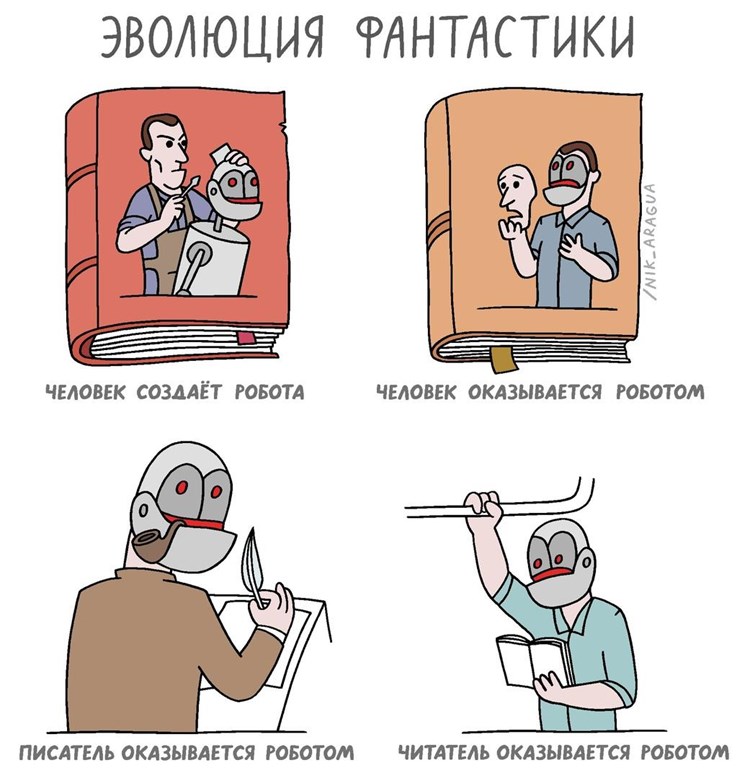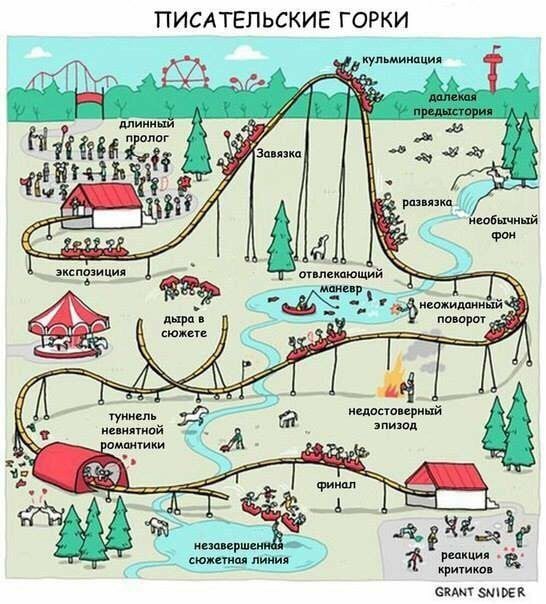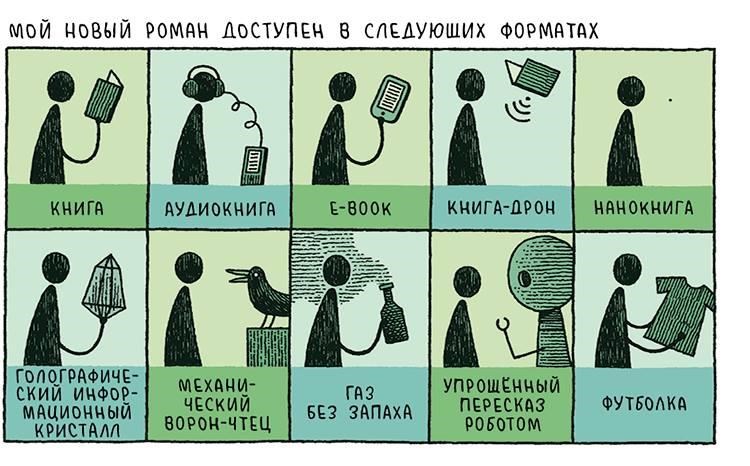How to find an idea
Constantly ask yourself the question “Can't I make a story out of this? And from this? And from this? " If you ask yourself it often enough, then sooner or later you will have a curious idea. From experience, you cannot pick up a good scientific and pop book and put it back on the shelf without reading at least two or three ideas.
Specifically, with this story it turned out like this: I watched a YouTube video by psychologist Evgenia Streletskaya and heard the following thought: when people just start dating, they love not so much a partner as a fictional image. Over time, the relationship develops, and the image gives way to more realistic representations of another person.
"Isn't it possible to write a story about this?" - I thought on the machine. And I decided that it was possible.
I decided to confront the fictional image of a person with the person himself. This is a dramatic situation. As the saying goes, "makes you think." The text will not be empty.
2. How to think
Bed, bath, bus. If you sit down at the table, open your laptop and ask yourself questions of the level "What kind of past should character X have in order for him to do Y?", Then you will not think of anything. Go to wash the dishes, take the subway. In a semi-focused state, your unconscious will give out what it needs. For more details, see Daniel Kahneman's book Thinking fast and slow.
3. What character is needed
You can't come up with a good storyline without the right character. Characters do things. And if in a book or film we see an act that happened because the author wanted it, and not because the character wanted it, then this is a bad book or movie.
Replace Dr. House with a regular doctor, and we have a set of sluggish medical cases, not a tragicomedy. Replace the rebel McMurphy in One Flight Over the Cuckoo's Nest with an ordinary patient, and we will have nothing at all.
So, for this text we need a person and his image, which was formed by the partner at the beginning of the relationship. An image stored in someone's head is boring, so let's take a robot. (Being a science fiction writer is very convenient: you can always involve a robot, a time machine, a neural interface, etc.)

I came up with the following situation: a young man is in love with a classmate - alas, not mutually. In our time, he would download her selfie for himself, and in the future he can create a robot that looks like her like two drops of water. Time passes, they meet - he, she and her robot.
Now the question is: what should a girl be? If this is an ordinary person, then the reaction to the meeting will be within the exclamation “Wow, what a robot! It's me. Fuck. " It's boring. I thought that if the heroine (let's call her Anna) was going through clinical depression, then the meeting would be an emotional shake-up for her.
The fact is that a depressed person experiences what is called "cognitive distortion." In particular, he or she constantly thinks: “I am a nonentity”, “I can’t do anything,” “I don’t deserve anything,” etc. This is, firstly, not true, and secondly, it spoils the mood and makes you lose strength.
Usually, a meeting with reality brings such a person to life. Therefore, when Anna comes face to face with a copy of herself made ten years ago, it will at least give a rebuff to the obsessive thoughts "I have not achieved anything" and "I have lived in vain."
Note: of course, any person is subject to cognitive biases, including the conditionally mentally healthy. But with clinical depression, cognitive distortions overload the brain so that it becomes like the CPU of a computer on which the virus mines bitcoins. For more on this view of disease, see David D., MD Burns, Feeling Good: The New Mood Therapy.If you immerse the reader in the mindset of a depressed person in advance, then the meaning of the conflict will become clear without boring lectures.
The meeting, by the way, will close that very “character arc”. It is believed that the character must change during the course of the action. In Hollywood, scripts start with the question "How will the character change?"
4. How to design a plot
This is a topic for a couple of thick books. Let's dwell on a couple of main points:
- The hero must always want something
- His actions must flow from his desires.

Let's hide the robot from Anna and from the reader. Situation: a young man keeps a copy of Anna's robot. Ten years after graduation, Anna and the young man start dating. They move in, but he can't just take the robot to the trash heap (I'm used to it, it's a pity). He hides the robot in a closet. The robot lives in the house, sometimes makes noise at night. The noise leads Anna to bad thoughts. Neighbors with casual remarks arouse suspicion.
Anna's path from suspicion to revealing the truth, the actions that she performs along the way, is the plot. In fact, we got a detective line.
The plot of the story should be an event. Anna is going through a divorce, falls ill with depression (she herself does not fully understand this) and loses her job. This is the plot. No work, no funds. Anna is forced to move to a young man. Thus, we drove the characters (including the robot) into one place. It remains to make sure that they learn the whole truth about each other.
5. How to trick the reader
Since we have a detective story, it's a sin not to use the favorite trick of detectives, which is called "red herring" (red herring). Namely: we can throw in information that leads away from the correct solution. Let's try to convince the reader that Anna's new young man has a skeleton in the closet and / or sleeps with a robot (and this is condemned by the public).
Let's also think about the denouement: let's say a young man does get the determination to dispose of the robot. How is this going to happen? A recycling man will come. When this guy enters the house, he may meet Anna (confusion is interesting!), But decides that she is the robot to be disposed of. It will give the robot a voice command, similar to what we write on the command line when we want to kill a process.
To make this moment more interesting, we can put a “red herring” at the beginning of the story. For a non-techie, the voice command will sound like God knows what. Or as a magic spell in an ancient language. Great, let Anna, throughout our story, dream that a person will appear in her life who will cast a spell, and thereby change her life and / or past (this fits perfectly into the mindset of a person who is constantly sad and blames himself in errors).
Therefore, when a man appears in the text and a voice command sounds, Anna (and the reader) will decide that something amazing is happening, possibly mystical.
6. Profit!

The story is ready. It remains to present the events in the reverse order: from the beginning to the denouement. If I were writing a script for a TV show or film, I would start with a change in the heroine's life: with a divorce or a dismissal. Since I still look up to the classics of SF (Ray Bradbury, Strugatsky brothers), and my reader will not be frightened by thinking characters, I started with a chain of intertwining dialogues.
As a rule, the story is more difficult to come up with than described in this article. You need to come up with and discard dozens of options, and most importantly, creativity is not limited to a set of techniques and schemes, although they help a lot.
But there is definitely nothing mystical about him.
If you liked it, you can download my stories here or hire me to work here .
List of references
Will Storr, The Science of Storytelling
Lisa Cron, Wired for Story
David Howard & Edward Mabley, The Tools of Screenwriting